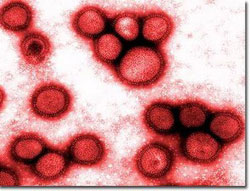Low humidity makes flu strong
American scientists have found a response to the "old" question that why flu has thrived in the winter days - because it's the time when "absolute" humidity is lower than other seasons.

Flu viruses can survive longer and spread faster when the "absolute" humidity is low.
According to research conducted by Oregon State University scientists (US) published in the February 9 issue of "Proceedings of the National Academy of Science," influenza viruses can survive longer and spread. faster when the "absolute" humidity is low.
"Absolute" humidity is the measurement of the actual amount of water vapor in the air, not depending on the temperature, other than the "relative" humidity, which is the measurement of the ratio of water vapor in the air depending on temperature.
Previous studies have concluded that the incidence of influenza is usually higher when the weather is colder and drier but often uses "relative" moisture to determine the rate of influenza infection.
However, when reviewing these studies, scientists found that "relative" moisture only explained 12% of flu infections and 36% of flu viruses persisted longer in the air.
Meanwhile, "absolute" humidity explains the cause of 50% of flu cases and up to 90% of influenza virus schools survive longer. This new finding is important for science and medical researchers because they can develop more effective models for preventing influenza.
- Humidity makes us uncomfortable when it is hot
- '100% moisture' means air has become water?
- Lack of storage temperature during transport of pharmaceuticals may affect the effect of the drug
- Why does dampness cause discomfort to the body?
- Humidity and human health
- Detecting geckos climbing faster in wet environments
- Why is the climate warming but the winter is cold?
- Remote temperature and humidity monitoring system
- How to understand the weather forecast indicators: UV index, rainfall, temperature, humidity
- Preventing and treating dengue fever with male medicine
- Video: Bullet line helps Canadian gunner to lower IS rebels from 3.5km
- Red alert of the risk of Southwestern forest fire in the United States
 Why do potatoes have eyes?
Why do potatoes have eyes? 'Tragedy' the world's largest carnivorous life: Death becomes ... public toilet
'Tragedy' the world's largest carnivorous life: Death becomes ... public toilet Tomatoes were once considered 'poisonous' for 200 years
Tomatoes were once considered 'poisonous' for 200 years Detecting microscopic parasites on human face
Detecting microscopic parasites on human face